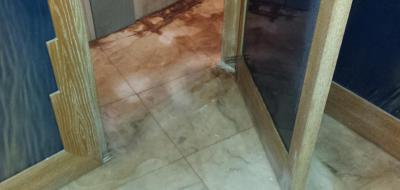Marble or natural stone that suffer water damage have to be renovated by grinding to recover their initial state.
Stains related to water damage
Water damage can cause several types of stains according to the type of stone, the source of the water and its composition. In case of flooding, water stands still for a certain time and is able to penetrate the stone at the surface.
The composition of the water then is very important since the elements in the water will stain the stone. The porosity of natural stone allows the stains to penetrate more or less deeply.
In other cases the water passes through the stone by pressure and/or capillary action. The stone is then often stained in the mass. In this case, renovation may reduce the stains on the surface but a perfect result is often impossible.
Grinding or stripping of the stone
Depending on the type of stain and the depth of penetration it will often be necessary to grind the stone to recover a maximum of the penetrated stains.
This grinding may also be coupled with one or more stripping sessions to remove most of the substance that penetrated the natural stone. Marble or natural stone that were subjected to water damage often have to be renovated by grinding to recover their initial state.
Renovation of marble after water damage in Paris
In this particular case the water stood still on the floor for a rather long time. The floor was surrounded by elements in wood. The water was infused with tannins and turned brown. The water then penetrated the floor (a Tassos marble)in a limited way. All the stains were recovered by grinding and stripping.
The marble was then polished with a honed finish.

